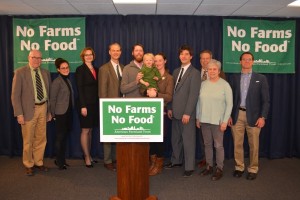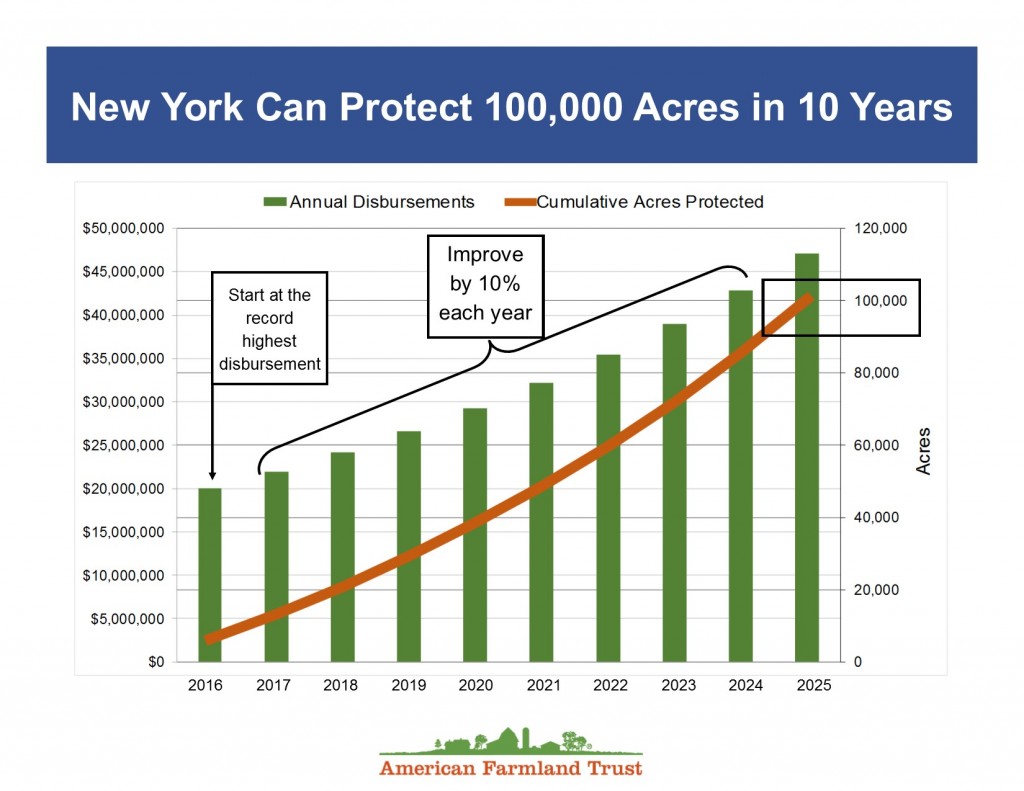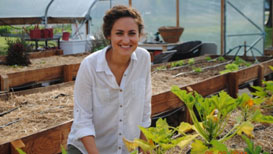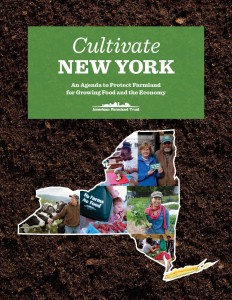By Sanaz Arjomand, M.S. in Environmental Policy 2016
During my internship with the New York field office of American Farmland Trust (AFT), a national organization whose mission is to protect farmland, promote sound farming practices, and keep farmers on the land, my main responsibility was to work on a report entitled Cultivate New York: An Agenda to Protect Farmland for Growing Food and the Economy. It commemorates the 20th year of New York State funding for permanent farmland protection through the purchase of development rights.
This report, which was released on January 11 at a press event at the state capitol, was very much a collaborative effort, and one that helped me put my analytic skills, honed during my year of coursework at Bard Center for Environmental Policy (CEP), to use. As mentioned in my previous post, one of the main parts of putting this report together has been to propose concrete, feasible, and impactful goals and recommendations for state farmland protection in the next ten years.

Governor Cuomo has recently helped revitalize state farmland protection, with the largest ever budget for farmland protection in State Fiscal Year 2015-2016 at $35 million. In the most recent round of Farmland Protection Implementation Grants (FPIG), two projects were completed in the record time of six months. In meetings with the Governor’s staff and in this report, AFT has urged Governor Cuomo to continue this positive momentum by adopting a goal of permanently protecting 100,000 acres in New York in the next 10 years.
How many acres?
We came to the 100,000 acre figure from several angles.
- Asking project partners: In an online survey sent to previous applicants to FPIG, AFT found that the 21 counties, municipalities, and land trusts who responded had goals of protecting about 100,000 acres all together within the next ten years. (See page 26.)
- Studying past achievements: This acreage goal would also represent significant progress, as it would be about twice the acreage protected throughout the history of the program in half the time—essentially quadrupling the pace of farmland protection in New York State. (See page 23.)
- Comparing with neighboring states: Finally, since New York loses about 5,000 acres of farmland per year, this figure would represent protecting twice as many acres as New York would lose at the current pace, a goal which other neighboring states have already exceeded. (See page 25.)
Is it feasible?
In its first 20 years, New York State’s FPIG has helped to permanently protect 56,165 acres on 232 farms, at a cost of $140,206,211. Though these achievements are significant, this cumulative amount of money actually spent on farmland protection was only about half of the amount appropriated by the state legislature. There are many efficiencies that need to be adopted to ensure that appropriations are spent in order to reach the goal of 100,000 acres in ten years, and these are the subject of the other goals and recommendations of the Cultivate New York report.
With this in mind, I set about calculating several disbursement scenarios. What I found was that if the State were to begin by disbursing at its peak performance to date of about $20 million in a state fiscal year (achieved in 2007), and improve spending incrementally by 10% per year, the 100,000 goal could be reached within ten years. I calculated these figures with average of dollars spent per acre in the most recent FPIG round after considering several potential measures of center that I learned about in statistics at Bard CEP.

Is it impactful?
The report focuses on three main statewide benefits of farmland protection that align with other political priorities of the current administration. The first is that protecting farms from development in sprawling urban areas protects the local food supply of those areas. The second is that farmland is the necessary base for a growing economic sector that includes impacts from farming, food processing, distributing, and other related industries. Finally, the aging farm population needs an alternative to selling their farmland to developers to ensure that new and beginning farmers will have access to productive farmland.
Using these three policy priorities, I projected the benefits of protecting 100,000 acres of farmland in ten years.¹
- Local food: 100 million entirely local meals per year
- Economic growth: $520 million in statewide economic impact
- New and Beginning farmers: 1,000 new and beginning farmers supported
Protecting 100,000 acres of New York’s farmland, described as an “irreplaceable state asset” in the state Agriculture and Markets Law, would push the program to perform at its best, and to continue making progress each year. It is doable. And it will have important impacts statewide.
No singular course could have taught me how to complete my internship with AFT. Instead, a combination of the analytic skills that I strengthened in my classes at Bard CEP—from Statistics and Econometrics to Environmental Politics and Policy—and the ability to consider an issue from economic, scientific, and political angles simultaneously, have been instrumental to my work with the Cultivate New York report.
¹Calculations for New Yorkers fed per acre from Peters et al., 2007 and conversations with corresponding author. As 4.62 million people could be fed with five million acres, this person per acre value was translated into about 1,000 meals per acre and then multiplied by the goal of 100,000.
Calculations for number of farms protected based on the median farm size for New York in the 2012 USDA NASS Agricultural Census. The goal of 100,000 acres was divided by the about 100 acre median farm.
Calculations for economic impact per acre based on Lopez et al., 2013. Total economic impact was divided by total number of acres for New York State.


